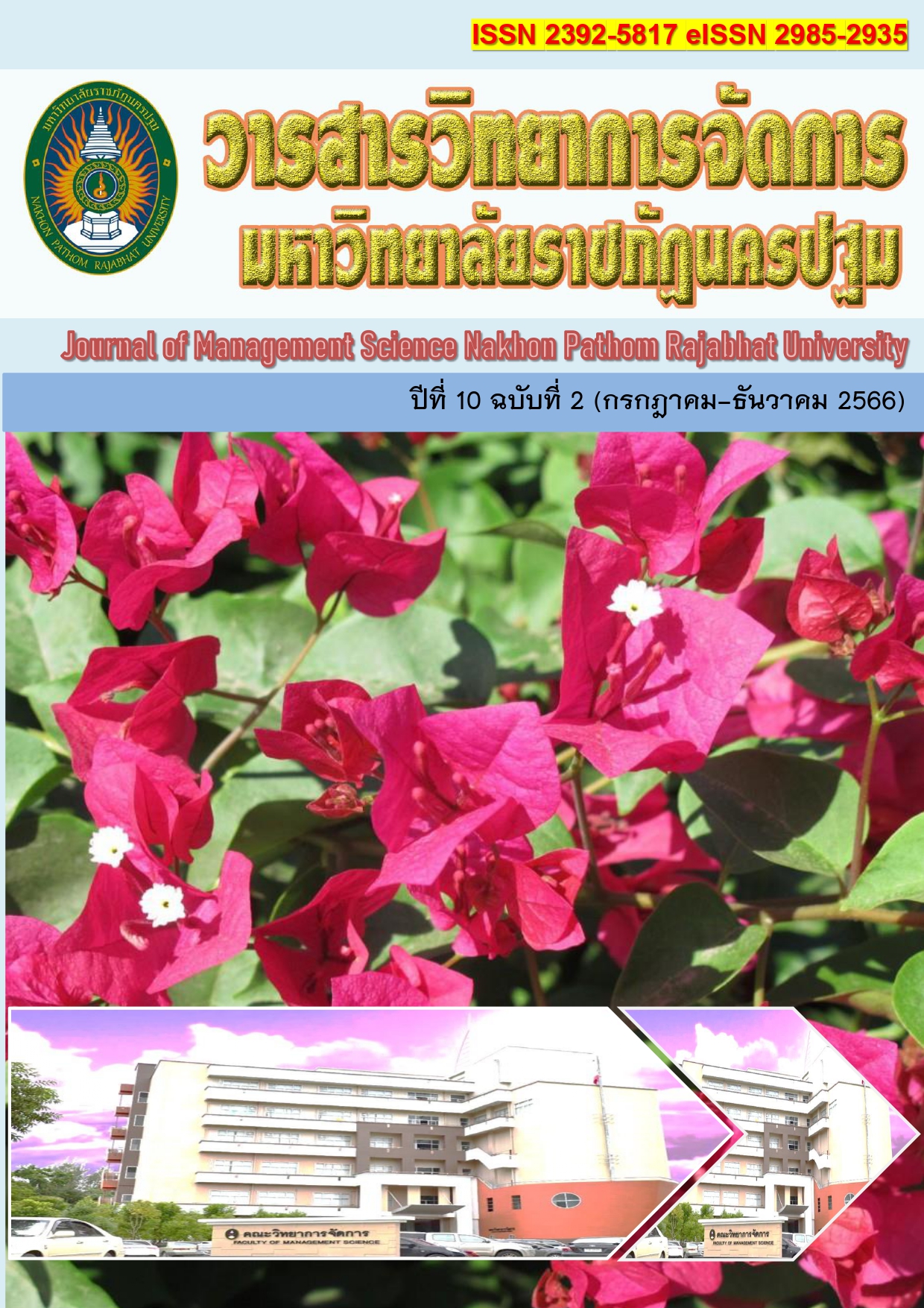Behavior, Satisfaction, and Happiness in Joining the Open Chat Group's LINE Application Happy Money Happy Market by RMUTT
Main Article Content
Abstract
The research results found that: clients use the open chat group at their convenient time, every day. The products that they purchase the most are everyday goods. The average cost per 1 purchase is 1,001-1,500 baht, the product was purchased for themselves and the person who has the most influence is friend. The satisfaction of usage the service is the highest level of satisfaction in terms of place or distribution channels followed by people or system administrator of the open chat group. The happiness before and after participation the application line open chat group found that there was a statistically significant difference at the level 0.01, the sample group was happier after participation.
Article history: Received 6 March 2023
Revised 8 October 2023
Accepted 10 October 2023
SIMILARITY INDEX = 6.48 %
Article Details

This work is licensed under a Creative Commons Attribution-NonCommercial-NoDerivatives 4.0 International License.
The views and opinions of the article appearing in this journal are those of the author. It is not considered a view and responsibility of the editorial staff.
References
กฤษณี เสือใหญ่. (2558). พฤติกรรมการใช้แอปพลิเคชันไลน์ ความพึงพอใจและการนำไปใช้ประโยชน์ของคนในกรุงเทพมหานคร. ศิลปศาสตร์มหาบัณฑิต (นิเทศศาสตร์และนวัตกรรม). สถาบันพัฒนบริหารศาสตร์.
เกศปรียา แก้วแสนเมือง (2558). พฤติกรรมการใช้และความพึงพอใจจากแอปพลิเคชันไลน์ (LINE) ของผู้ที่อยู่ในกลุ่มอายุ 25-45 ปี ในเขตกรุงเทพมหานคร. วารสารศาสตรมหาบัณฑิต สาขาวิชาการจัดการสื่อสารองค์กร. มหาวิทยาลัยธรรมศาสตร์.
คณะการแพทย์บูรณาการ มหาวิทยาลัยเทคโนโลยีราชมงคลธัญบุรี. (2565). ประชาสัมพันธ์โครงการ “การเสริมสร้างสุขภาพดีกับการทำงานอย่างมีความสุขด้วยศาสตร์การแพทย์แผนไทย”, [ออนไลน์]. ค้นเมื่อ 26 มีนาคม พ.ศ. 2565, จาก https://www.im.rmutt.ac.th/?p=19252
ชลิต ธีระชิตกุล. (2562). ปัจจัยที่มีผลต่อการซื้อสินค้าหรือบริการของผู้บริโภคต่อโฆษณาผ่านแอปพลิเคชันไลน์ ในเขตกรุงเทพมหานคร. การค้นคว้าอิสระนิเทศศาสตรมหาบัณฑิต สาขาวิชาการสื่อสารเชิงกลยุทธ์. มหาวิทยาลัยกรุงเทพ.
ณัฐรุจา พงศ์สุพัฒน์. (2561). การศึกษาตลาดแอปพลิเคชันอาหารและพฤติกรรมผู้บริโภคต่อการตัดสินใจเลือกใช้บริการแอปพลิเคชันอาหาร. บริหารธุรกิจมหาบัณฑิต. มหาวิทยาลัยธรรมศาสตร์.
ทัศนีย์ วงค์สอน. (2562). ปัจจัยส่วนประสมทางการตลาดและพฤติกรรมของผู้บริโภคที่ส่งผลต่อการซื้อซ้ำ ผลิตภัณฑ์ผ้าฝ้ายทอมือของกลุ่มผ้าฝ้าย อำเภอจอมทอง จังหวัดเชียงใหม่ .บริหารธุรกิจมหาบัณฑิต สาขาวิชาการบริหารธุรกิจ. มหาวิทยาลัยราชภัฏเชียงใหม่. [ออนไลน์]. ค้นเมื่อ 26 กุมภาพันธ์ 2566, จาก https://dric.nrct.go.th/Search/SearchDetail/306761
ธนพร สุขทรัพย์ กชกร สุขทรัพย์ และ ยศกร สุขทรัพย์. (2565). พฤติกรรมและปัจจัยในการตัดสินใจเลือกใช้บริการสั่งอาหารออนไลน์ของผู้บริโภคในกรุงเทพมหานคร. วารสารสหวิทยาการมนุษยศาสตร์และสังคมศาสตร์, 5(2), 489-502
ธีรพร สิริวันต์. (2559). การศึกษาพฤติกรรมการใช้ไลน์แอปพลิเคชัน (Line application) เพื่อเป็นช่อง ทางการสื่อสารการปฏิบัติงานในองค์กร. การจัดการมหาบัณฑิต. มหาวิทยาลัยมหิดล
นิจกานต์ หนูอุไร. (2564). พฤติกรรมการใช้ประโยชน์และความพึงพอใจจากแอปพลิเคชันไลน์ที่ส่งผลต่อการรู้เท่าทันสื่อของผู้สูงอายุในเขตอำเภอเมือง จังหวัดสงขลา. JOURNAL OF HUMANITIES AND SOCIAL SCIENCES SONGKHLA RAJABHAT UNIVERSITY, 3(1), 145-176.
บาลีภัทร ลิ้มธงเจริญ. (2561). ปัจจัยในการใช้แอปพลิเคชันที่ส่งผลต่อประสิทธิผลการทำงานของพนักงานกรณีศึกษา บริษัทเอกชนด้านโลจิสติกส์. บริหารธุรกิจมหาบัณฑิต การจัดการอุตสาหกรรม. สถาบันเทคโนโลยีไทย-ญี่ปุ่น.
ลิน, แดน แดน. (2017). พฤติกรรมการใช้ปัจจัยด้านเทคโนโลยีและการยอมรับแอปพลิเคชันวีแช็ตในประเทศไทย: กรณีศึกษา กรุงเทพมหานคร. วารสารศาสตรมหาบัณฑิต สาขาวิชาการบริหารสื่อสารมวลชน. มหาวิทยาลัยธรรมศาสตร์.
ศิรินันท์ กิตติสุขสถิต เฉลิมพล แจ่มจันทร์ กาญจนา ตั้งชลทิพย์ และ จรัมพร โห้ลำยอง. (2555). คู่มือการวัดความสุขด้วยตนเอง (HAPPINOMETER: The Happiness Self Assessment). นครปฐม: สถาบันวิจัยประชากรและสังคม มหาวิทยาลัยมหิดล.
สมิธ พิทูรพงศ์. (2561). การใช้แอปพลิเคชันไลน์ในกระบวนการทำงาน: กรณีศึกษาบริษัทสหผลิตภัณฑ์พาณิชย์ จำกัด. การค้นคว้าอิสระนิเทศศาสตรมหาบัณฑิต สาขาวิชาการสื่อสารการตลาดดิจิตอล. มหาวิทยาลัยกรุงเทพ.
สุนันทรา ขำนวนทอง พิทยุตม์ คงพ่วง พิมพ์พรรณ อำพันธ์ทอง และ วัชรี เพ็ชรวงษ์. (2565). การมีส่วนร่วมในชุมชนและการใช้สื่อสังคมออนไลน์มีผลต่อรูปแบบความสุขของผู้สูงอายุ ในยุค 4.0 ตำบลวังหว้า อำเภอศรีประจันต์ จังหวัดสุพรรณบุรี. วารสารสังคมศาสตร์และมานุษยวิทยาเชิงพุทธ. 7(12), 698-713.
สำนักงานกองทุนสนับสนุนการสร้างเสริมสุขภาพ. (2565). การให้คุณค่าและรับฟังเสียงพนักงาน ปัจจัยสร้างองค์กรแห่งความสุขในอนาคต. [ออนไลน์]. ค้นเมื่อ 26 มีนาคม พ.ศ. 2565, จากhttps://resourcecenter.thaihealth.or.th/article/ การให้คุณค่าและรับฟังเสียงพนักงาน - ปัจจัยสร้างองค์กรแห่งความสุขในอนาคต
Alexandrova, A. (2005). Subjective well-being and Kahneman’s objective happiness. Journal of Happiness Studies, 6(3), 301-324.
Easterlin, R. A. (2001). Income and happiness: Towards a unified theory. The Economic Journal, 111(473), 465-484.
Kotler, P. & Armstrong G. (2004). Principles of Marketing. (10th ed.) New Jersey: Pearson.
Leavitt, H. J. (1964). Applied organization change in industry: structural, technical and human approaches. In J. G. March (Ed.), Handbook of organisation. Illinois: Rand McNally and Company.
Li, S., & Jaharuddin, N. S. (2021). Influences of background factors on consumers’ purchase intention in China’s organic food market: Assessing moderating role of word-of-mouth (WOM). Cogent business & management, 8(1), 1876296.
Line Corporation. (2021). LINE OPEN CHAT. [ออนไลน์]. ค้นเมื่อ 26 มีนาคม พ.ศ. 2565, จากhttps://linecorp.com/th/ pr/news/th /2021/3861.
Ngoma, M., & Ntale, P. D. (2019). Word of mouth communication: A mediator of relationship marketing and customer loyalty. Cogent Business & Management. 6(1). DOI: 10.1080/23311975.2019.1580123
Shelley, M. W. (1975). Responding to Social Change.Pennsylvania: Dowden, Hutchison: 252-268 Philip. (2000). Marketing Management, The Millennium Edition. New Jersey: Prentice Hall.
Tortoisesheller. (2019). Customer satisfaction กับผู้บริโภคยุค 4.0, [ออนไลน์]. ค้นเมื่อ 23 พฤษภาคม 2565, จาก https://medium.com/@thanyalakek/customer-satisfaction
Veenhoven, R. (1991). Is happiness relative?, Social Indicators Research. 24(1): 1-34.


